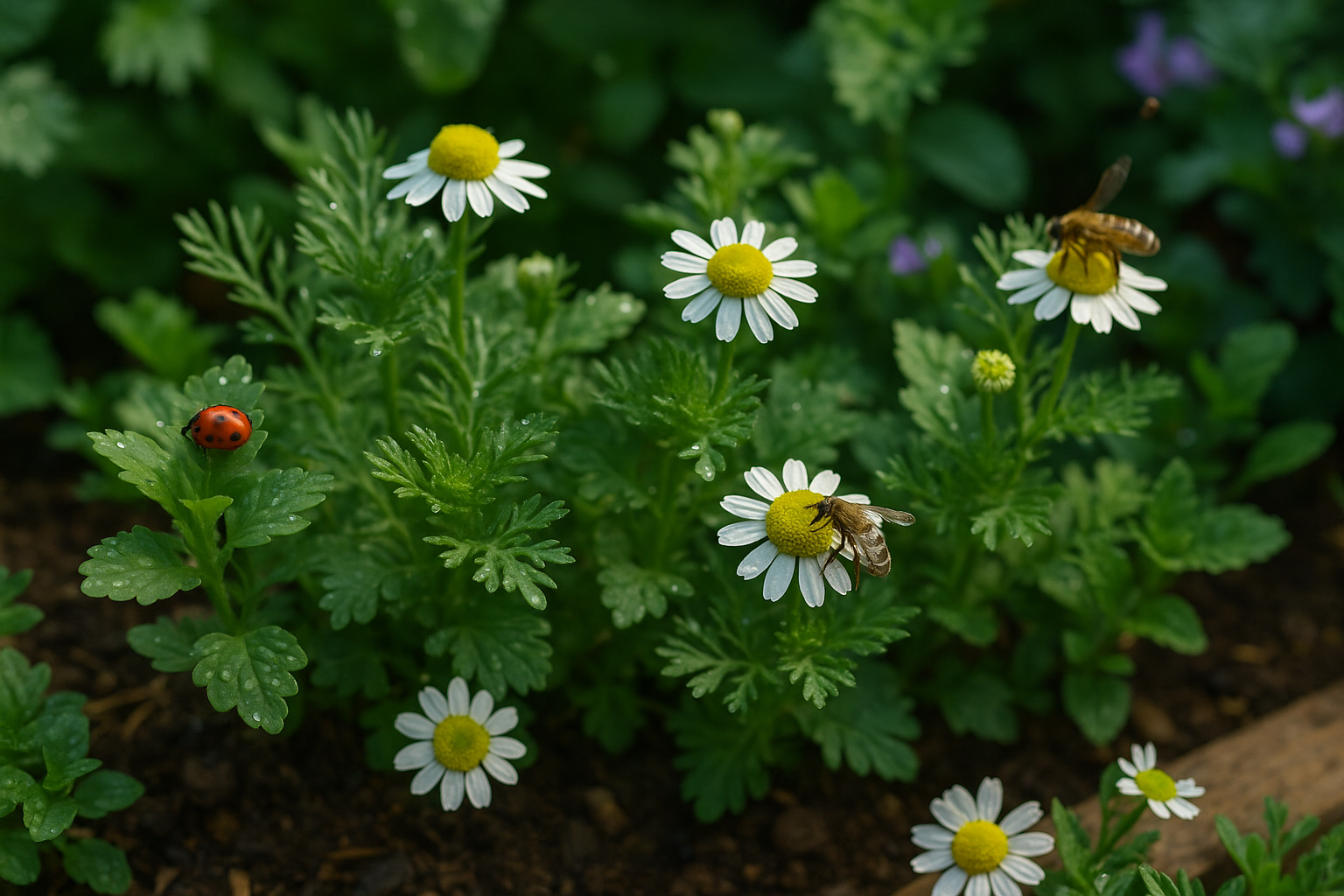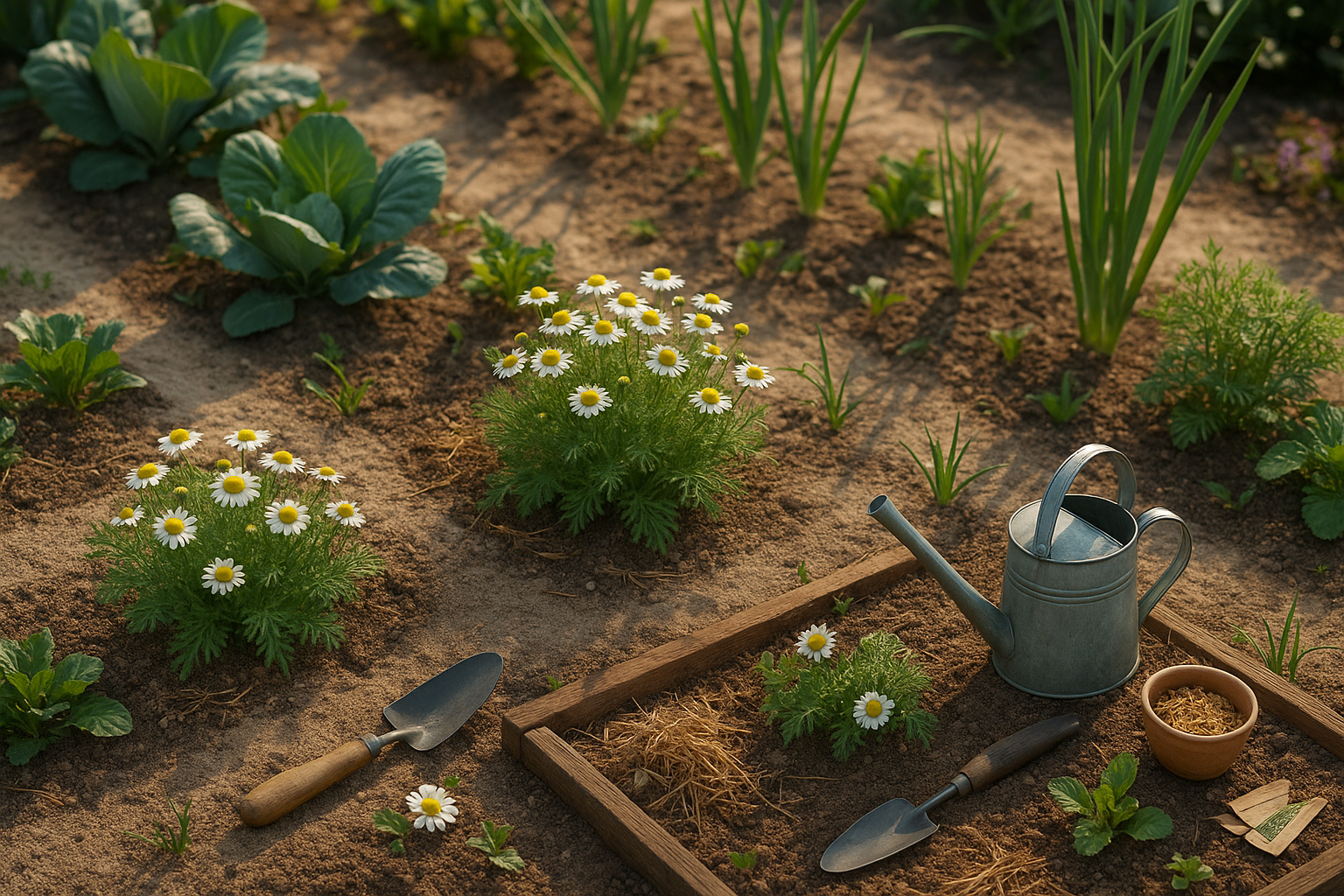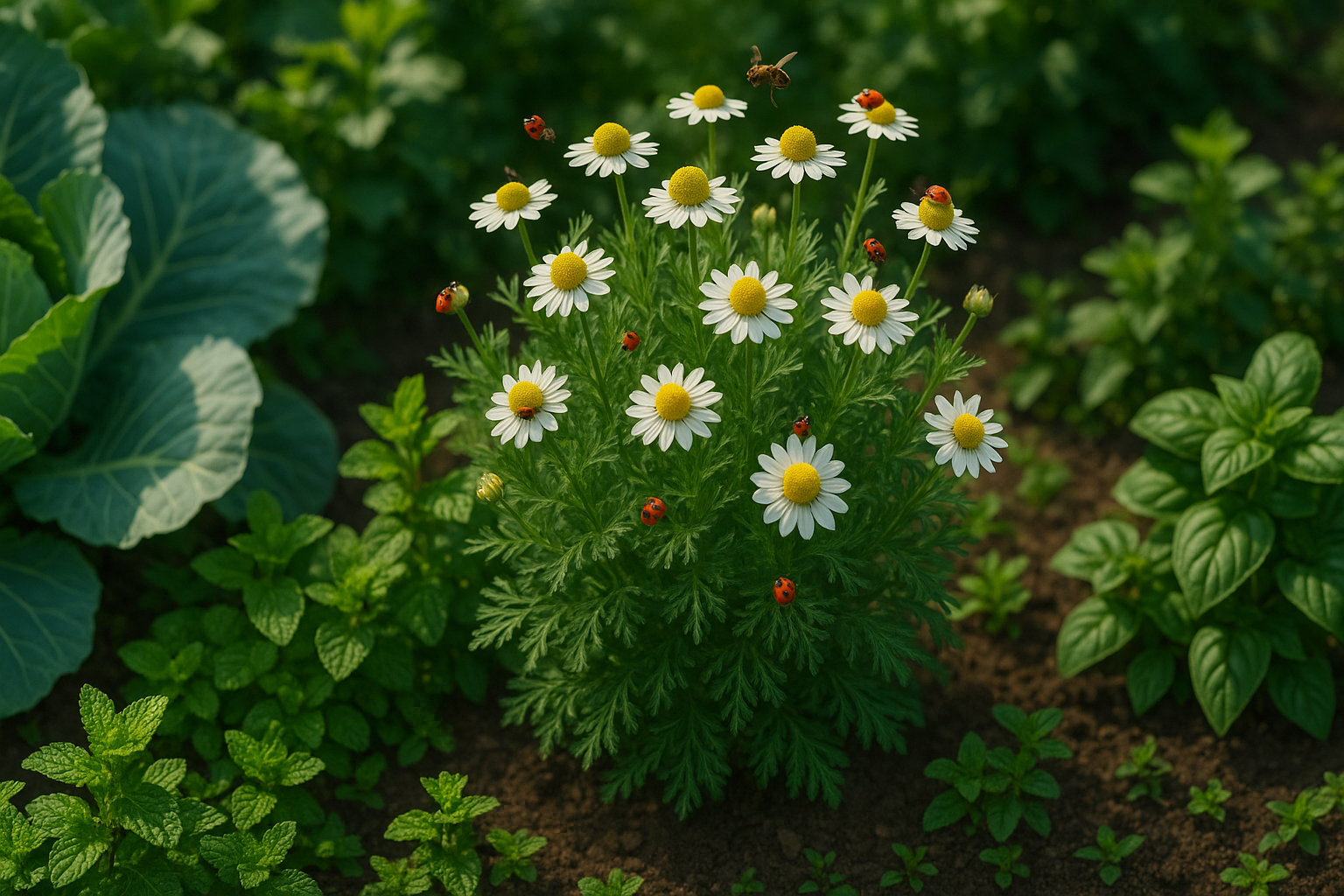Introduction
Chamomile companion plants are a hot topic for gardeners wanting to get the most out of their herb patches. Chamomile, prized for its soothing tea and delicate apple-scented blooms, is more than just a pretty face in the garden. Its versatility makes it a staple in organic gardening—not only for its calming qualities but also for its natural ability to support surrounding plants. That’s where companion planting comes in: pairing certain species to boost growth, resilience, and flavor, while reducing the need for chemical fertilizers or pesticides.
If you’re new to gardening or looking to maximize your harvest organically, understanding how chamomile interacts with its neighbors is key. In this post, we’ll explore which vegetables, herbs, and flowers thrive as chamomile companion plants, offer practical tips for planting layouts, and share how these pairings can deter pests, attract pollinators, and improve your garden’s overall health. Whether you have a dedicated herb bed or a mixed veggie patch, read on to discover the best allies for chamomile and how to set your garden up for success.
Benefits of Companion Planting with Chamomile

Companion planting with chamomile offers numerous benefits for your garden, making it a valuable addition among herbs and vegetables alike. As a natural pesticide, chamomile releases subtle scents and compounds that help deter common garden pests such as aphids, mosquitoes, and whiteflies. This provides sensitive neighbors like lettuce or cabbage with an organic shield against infestations.
Beyond pest control, chamomile is well known for attracting beneficial insects like ladybugs, lacewings, and hoverflies—these tiny helpers feast on harmful pests, maintaining a healthy ecosystem and reducing the need for chemical treatments. Its cheerful, daisy-like blooms also attract pollinators such as bees and butterflies, boosting the productivity of nearby fruiting and flowering plants.
Another advantage is chamomile’s positive influence on plant growth. Its roots improve soil health by adding key nutrients and enhancing microbial activity, especially benefiting plants that thrive in nutrient-rich soil, like basil and onions. Additionally, research and gardeners’ experiences suggest that chamomile can help neighboring plants resist fungal diseases by releasing antifungal compounds through its roots and fallen petals.
Chamomile doesn’t just support other plants—it also benefits from certain companion plants. For example, placing chamomile near aromatic herbs like mint can protect its delicate flowers from some beetles, while tall vegetables such as tomatoes provide welcome shade during hot afternoons. All these synergies make chamomile a smart, multifunctional addition to any companion planting layout.
Best Vegetables to Plant with Chamomile
Chamomile companion plants play a crucial role in creating a thriving vegetable garden, and several classic vegetables benefit from sharing space with this charming herb. One of the top companions is cabbage. Chamomile naturally emits a gentle scent that deters pests like cabbage moths and aphids, making it a helpful neighbor to cabbages. It also attracts beneficial insects such as hoverflies and ladybugs.
Onions pair well with chamomile too; the herb’s pest-repelling properties help keep onion flies at bay, protecting the crop. Additionally, chamomile is known to subtly enhance the flavor of nearby vegetables—some gardeners even report that onions grown close to chamomile develop a richer taste. Broccoli is another excellent partner, as it is also prone to aphids and cabbage worms, both of which chamomile effectively discourages. The presence of chamomile can even improve soil health and boost essential oil production in broccoli, potentially enhancing its nutritional value and flavor.
Beans, including both bush and pole varieties, are a smart addition to beds with chamomile. Beans are nitrogen-fixers, enriching the soil for the benefit of all nearby plants, including chamomile. In return, chamomile’s insect-repelling qualities help protect beans from Mexican bean beetles and aphids. However, be mindful of spacing—beans can grow large and leafy, so make sure chamomile isn’t overshadowed and receives plenty of sunlight.
If you’re planting chamomile near young cabbage or broccoli seedlings, give each plant enough room to develop without crowding, as these vegetables appreciate some breathing space. By combining chamomile with cabbage, onions, broccoli, and beans, you create a mutually beneficial environment where flavors are enhanced, pests are kept in check, and the harvest is more rewarding for the home gardener.
Flowering Plants & Herbs That Pair Well with Chamomile
Chamomile is a gentle and versatile plant that thrives alongside a variety of flowering plants and herbs, making it an excellent companion in both ornamental and kitchen gardens. Calendula, for example, grows beautifully with chamomile—both enjoy similar conditions. Calendula’s bright blooms attract bees and hoverflies, which not only improve chamomile’s pollination but also help keep common pests in check.
Pairing chamomile with mint is another time-tested strategy. While chamomile encourages healthy growth in mint, the mint’s strong aroma acts as a natural repellent for aphids and ants that might otherwise bother your garden. Basil is yet another herb that benefits from proximity to chamomile. The two together can enhance each other’s flavor, and basil’s pest-repelling properties help protect chamomile from harmful insects like thrips and flies.
Roses also make great flowering partners for chamomile. The dainty chamomile flowers attract beneficial insects such as ladybugs and lacewings, which feed on aphids that commonly plague rose bushes. When designing your flower or herb bed, interplant chamomile in small clusters near the base of roses or between rows of basil and calendula.
Avoid overcrowding and ensure good airflow around plants to minimize moisture-related diseases. For spreading herbs like mint, use containers or soil barriers to manage their growth and prevent them from overwhelming chamomile’s delicate structure.
Planting chamomile among a diverse mix of chamomile companion plants not only boosts its health and productivity but also creates a vibrant, aromatic patch that naturally attracts pollinators and deters a variety of common garden pests. The result is a resilient, low-maintenance garden bed that thrives season after season while supporting local insect populations and enhancing the flavor and vitality of your herbs and blooms.
What Not to Plant Near Chamomile
While chamomile makes a wonderful companion plant for many herbs and vegetables, there are some you should keep at a distance—especially those from the nightshade family like tomatoes, peppers, and potatoes. These crops are poor chamomile companion plants for several reasons.
First, chamomile and nightshades often compete heavily for nutrients and water, particularly in less-than-ideal soil conditions. This competition can stunt the growth of both plants and reduce yields. Second, tomatoes, peppers, and potatoes are susceptible to similar fungal diseases, such as blight. Planting them near chamomile increases the risk of disease transmission between species, which can quickly spread throughout your garden.
Additionally, some studies suggest that chamomile releases allelopathic compounds—chemicals that influence the growth of nearby plants. While these compounds help many herbs and flowers by deterring pests, sensitive nightshades may experience stunted growth.
To avoid these negative interactions, it’s best to group chamomile with compatible herbs and vegetables rather than nightshade crops. Consider using raised beds or containers to keep these plant families separated. Design your garden so chamomile borders leafy greens or root crops, while tomatoes, peppers, and potatoes have their own dedicated space elsewhere.
This approach not only reduces competition and disease risk but also helps your chamomile and other plants thrive to their full, healthy potential.
Tips for Planting and Caring for Chamomile with Companions

When introducing chamomile companion plants into your garden, start by giving each plant plenty of space. Chamomile thrives in well-drained soil and prefers full sun, so choose a spot that receives at least 6 hours of sunlight daily. Space chamomile plants 8–12 inches apart to allow airflow and prevent overcrowding—this also benefits neighboring companions like basil and mint, which can become bushy.
If pairing chamomile with compact herbs such as thyme or oregano, stagger the plantings to ensure each gets enough sun and room for root growth. Use light, slightly sandy soil because chamomile and many common companions dislike heavy, soggy earth. Mulching with a thin layer of straw helps maintain soil moisture without overwatering. Typically, chamomile only needs one deep watering per week unless the season is particularly dry.
Chamomile’s light growth habit makes it a gentle neighbor to vegetables like onions or cabbage. Plant chamomile along the edges of these beds—it can help deter pests without competing aggressively for nutrients. Avoid over-fertilizing; too much nitrogen causes chamomile to become leggy and may reduce flower production.
Throughout the growing season, watch for aphids, which often gather on chamomile. A quick spray of water or introducing beneficial insects like ladybugs can control them effectively. Regular deadheading of chamomile blooms encourages more flowers and prevents unwanted reseeding among your companions. By giving each plant the right start and consistent care, your chamomile and companion plants will thrive together, creating a healthier and more productive garden.
Conclusion
Selecting the right chamomile companion plants is a simple yet effective way to boost your garden’s overall health and yield. By planting chamomile alongside compatible herbs or vegetables like basil, mint, cabbage, or cucumbers, you can take advantage of its natural pest-repelling properties and its ability to attract pollinators.
Equally important is avoiding pairing chamomile with strongly aromatic or aggressive plants, such as fennel or spreading varieties of mint, to prevent competition or overcrowding. Every garden has its own unique microclimate and soil conditions, so what works well in one space may require some adjustment in another.
Don’t hesitate to experiment—try different combinations each season, and keep notes on which plants thrive together and which don’t. Gardening is as much about discovery as it is about routine, so let your curiosity lead the way.
Have you tried chamomile companion planting before, or do you have a unique pairing that worked wonders in your garden? We’d love to hear your stories or answer your questions in the comments below. Sharing your experiences can inspire others and help us all cultivate stronger, healthier gardens.
